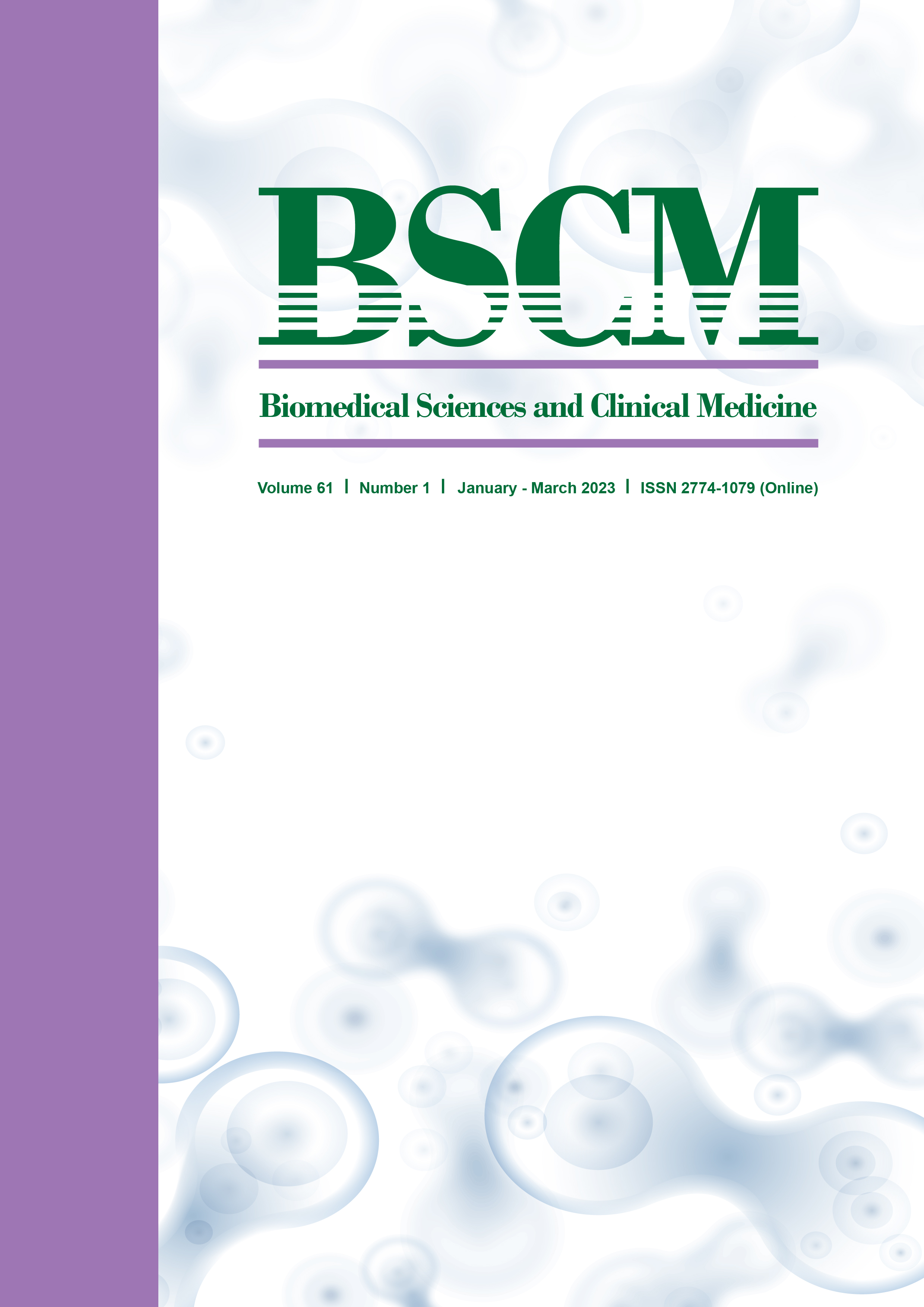ผลของการฟังดนตรีต่อการลดความเครียดของนักเรียนชั้นมัธยมศึกษาปีที่ 6
Main Article Content
บทคัดย่อ
วัตถุประสงค์ เพื่อศึกษาผลของการฟังดนตรีต่อการลดความเครียดของนักเรียนชั้นมัธยมศึกษาปีที่ 6
วิธีการ งานวิจัยนี้เป็นการศึกษาแบบกึ่งการทดลองแบบสองกลุ่ม (quasi-experimental study) ในนักเรียนชั้นมัธยมศึกษาปีที่ 6 ของโรงเรียนแห่งหนึ่งในจังหวัดกรุงเทพฯ ผู้วิจัยแบ่งอาสาสมัครออกเป็น 2 กลุ่ม ได้แก่ กลุ่มทดลองซึ่งได้ฟังดนตรีประกอบเสียงธรรมชาติต่อเนื่องเป็นเวลา 20 นาที และกลุ่มควบคุมซึ่งอ่านคู่มือคลายเครียดเป็นเวลา 20 นาที เครื่องมือวิจัยได้แก่ อัตราการเต้นของหัวใจ แบบประเมินความเครียดสำหรับคนไทย (Thai Stress Test) และแบบสอบถามมาตรประเมินค่าความเครียด (stress 5-point Likert’s scale) โดยวัดผลก่อนและหลังการทดลองของทั้งสองกลุ่ม วิเคราะห์ข้อมูลโดยใช้สถิติเชิงพรรณนา T-test และ Chi-square test
ผลการศึกษา อาสาสมัครที่เข้าร่วมการศึกษามีจำนวน 82 คน ผลงานวิจัยพบว่า กลุ่มทดลองมีค่าอัตราการเต้นของหัวใจ ระดับความเครียดจากแบบประเมินความเครียดสำหรับคนไทยและแบบสอบถามมาตรประเมินค่าความเครียดลดลงหลังฟังดนตรีอย่างมีนัยสำคัญทางสถิติ ในขณะที่กลุ่มควบคุมมีค่าอัตราการเต้นของหัวใจ ระดับความเครียดจากแบบประเมินความเครียดสำหรับคนไทยและแบบสอบถามมาตรประเมินค่าความเครียดไม่แตกต่างกันระหว่างก่อนและหลังการทดลอง แต่เมื่อเปรียบเทียบการลดลงของความเครียดระหว่างกลุ่มทดลองและกลุ่มควบคุมพบว่าแตกต่างกันทางสถิติ
สรุป การฟังดนตรีต่อเนื่องเป็นเวลา 20 นาที สามารถลดความเครียดทางร่ายกายและจิตใจได้ อย่างไรก็ตาม การลดลงของความเครียดจากการฟังดนตรีไม่แตกต่างจากการอ่านคู่มือคลายเครียด
Article Details

อนุญาตภายใต้เงื่อนไข Creative Commons Attribution 4.0 International License.
เอกสารอ้างอิง
Miryala RK. Trends, challenges & innovations in management – volume III. Telangana: Zenon Aca-demic Publishing; 2015.
Ojha U. managing teen stress. Psychosocial aspect of health and illness. Delhi: Global Vision Publish-ing House; 2015.
Chandra A, Batada A. Exploring stress and coping among urban African American adolescents: the shifting the lens study. Prev Chronic Dis. 2006;3: A40.
Jayanthi P, Thirunavukarasu M, Rajkumar R. Ac-ademic stress and depression among adolescents: a cross-sectional study. Indian Pediatr. 2015;52: 217-9.
Maritta V, Ruthaychonnee S, Minna A. Survey of adolescents’ stress in school life in Thailand: im-plications for school health. J Child Health Care. 2017;21:222-30.
Spear LP. The adolescent brain and age-related behavioral manifestations. Neurosci Biobehav Rev. 2000;24:417-63.
Dechkum K. A study of stress of Mathayom Suksa six students during the economic crisis. Bangkok: Chulalongkorn University; 1998.
Vo D, Park MJ. Stress and Stress Management Among Youth and Young Men. Am J Mens Health. 2009;2:353-66.
Khalfa S, Bella SD, Roy M, Peretz I, Lupien SJ. Ef-fects of relaxing music on salivary cortisol level after psychological stress. Ann N Y Acad Sci. 2003; 999:374-6.
Nater UM, Abbruzzese E, Krebs M, Ehlert U. Sex differences in emotional and psychophysiological responses to musical stimuli. Int J Psychophysiol. 2006;62:300-8.
Burns J, Labbé E, Williams K, McCall J. Perceived and physiological indicators of relaxation: as dif-ferent as Mozart and Alice in chains. Appl Psycho-physiol Biofeedback. 1999;24:197-202.
Juslin P, Sloboda J. Handbook of music and emo-tion: theory, research, applications. Oxford: Ox-ford University Press; 2010.
Jacobsen SL, Pedersen IN, Bonde LO, Odell-Mill-er H. A comprehensive guide to music therapy, 2nd Edition: theory, clinical practice, research and training. London: Jessica Kingsley Publishers; 2019.
Bonde LO, Wigram T. A comprehensive guide to music therapy: theory, clinical practice, research and training. London: Jessica Kingsley Publishers; 2002.
Chlan L. Music therapy as a nursing intervention for patients supported by mechanical ventilation. AACN Clinical Issues. 2000;11:128-38.
Solanki MS, Zafar M, Rastogi R. Music as a therapy: role in psychiatry. Asian J Psychiatr. 2013;6:193-9.
Watkins G. Music therapy: proposed physiological mechanisms and clinical implications. Clin Nurse Spec. 1997;11:43-50.
Lee O, Chung Y, Chan M, Chan W. Music and its effect on the physiological responses and anxiety levels of patients receiving mechanical ventila-tion: a pilot study. J Clin Nurs. 2005;14:609-20.
de Witte M, Spruit A, van Hooren S, Moonen X, Stams G-J. Effects of music interventions on stress-related outcomes: a systematic review and two meta-analyses. Health Psychol Rev. 2020;14: 294-324.
Linnemann A, Wenzel M, Grammes J, Kubiak T, Nater U. Music listening and stress in daily life-a matter of timing. Int J Behav Med. 2017;25: 223-30.
Phattharayuttawat S, Ngamthipwathana T, Sukhatungkha K. The development of the Thai Stress Test. 2000;45:237-50.
Elo A-L, Leppänen A, Jahkola A. Validity of a sin-gle-item measure of stress symptoms. Scand J Work Environ Health. 2004;29:444-51.
Linnemann A, Ditzen B, Strahler J, Doerr J, Nater U. Music listening as a means of stress reduction in daily life. Psychoneuroendocrinology. 2015;60: 82-90.
Allen K, Golden LH, Izzo JL, Jr., Ching MI, For-rest A, Niles CR, et al. Normalization of hyper-tensive responses during ambulatory surgical stress by perioperative music. Psychosom Med. 2001;63:487-92.
Thoma M, Marca R, Brönnimann R, Finkel L, Ehlert U, Nater U. The effect of music on the hu-man stress response. Plos One. 2013;8:e70156.
Han L, Li JP, Sit JW, Chung L, Jiao ZY, Ma WG. Ef-fects of music intervention on physiological stress response and anxiety level of mechanically venti-lated patients in China: a randomised controlled trial. J Clin Nurs. 2010;19:978-87.
Van Daele T, Hermans D, Audenhove C, Van den Bergh O. Stress reduction through psychoeduca-tion a meta-analytic review. Health Educ Behav. 2012;39:474-85.


